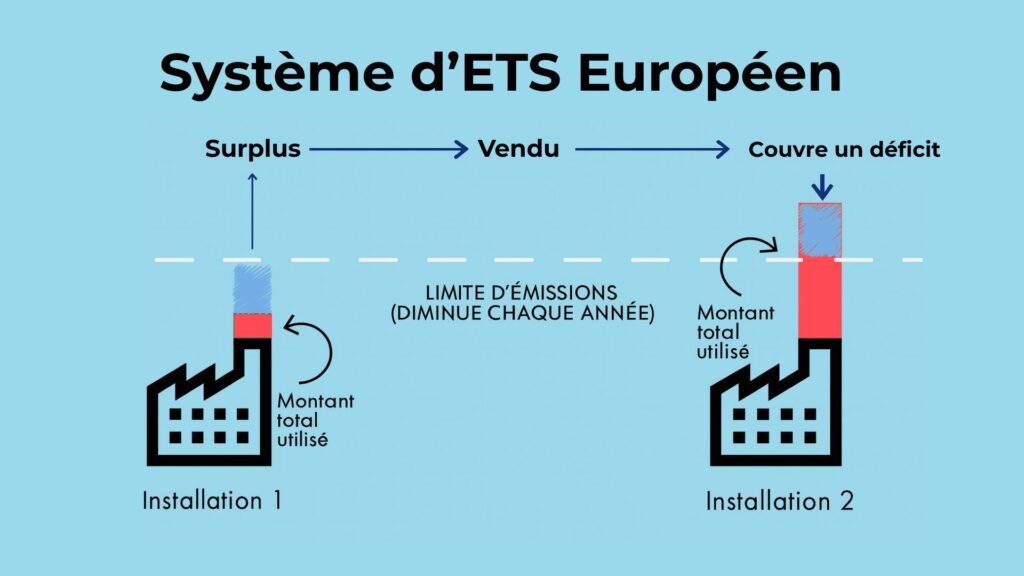Launched in 2005, the European Union Emissions Trading Scheme (EU ETS) is the Union's main tool for regulating greenhouse gas emissions. Operating on a "cap and trade" basis, it sets an annual emissions cap for certain economic sectors (energy, heavy industry, intra-European aviation, maritime from 2024), while allowing covered entities to buy or sell allowances on the market according to their performance.
The system has proven its effectiveness, with emissions cut by almost 50 % in sectors covered since 2005. Its latest reform, adopted in December 2022, further strengthens its ambition with a target of reducing emissions by 62 % by 2030 compared with 1990.

Today, the EU ETS has established itself as the world's largest regulated carbon marketwith a volume of 1,386 MtCO₂e traded in 2024 and a market value reaching 781 billion eurosgenerating 43.6 billion euros in revenues public sector. These figures make it a major strategic lever, not only for decarbonization, but also for financing the climate transition.
Why the EU ETS is crucial to carbon removal
While the EU is aiming for climate neutrality by 2050, a residual share of emissions will be difficult, if not impossible, to reduce, particularly in sectors such as aviation, chemicals and agriculture. This is where Carbon Dioxide Removal (CDR) come into play, enabling the permanent removal of CO₂. In order to give them an industrial scale, it is essential to guarantee a stable economic valueThis is why a regulated market like the ETS is one of the most effective, if not indispensable, mechanisms.
Integrating the CDR into the EU ETS would make it possible to :
- toincrease market liquidity ETS with the arrival of new certified units;
- toensure a sustainable outlet and value for EDC suppliers beyond the still uncertain voluntary markets.
It also offers a long-term visibility to the sector, an essential condition for unlocking the necessary investments, the costs of which remain higher than current quota prices (~80 €/tCO₂e).
Reform timetable and outlook
The integration of carbon removal technologies (CRTs) into the EU ETS is at a pivotal stage in the European regulatory calendar. Since the adoption from Carbon Removal and Carbon Farming (CRCF) end 2023, the European Commission has begun to implement the application framework, with the gradual adoption of delegated acts, the first of which will be published in the coming months. sector-specific methodologies for permanent disposal are now in force or in the process of being finalized. The CRCF establishes the technical, environmental and traceability standards that CDR activities must meet to be recognized in European policies, notably the ETS.
However, the integration of these credits into the ETS market requires a separate regulatory review. With this in mind, the In April 2025, the European Commission launched a 12-week public consultationclosed on July 8, 2025as part of the assessment provided for in the ETS directive. The aim is to collecting opinions on a revision in 2026including sectors covered, market governance, treatment of residual emissions, and the opportunity to integrate certified carbon offsets.
The 2025-2026 period therefore represents a strategic window of influence for economic players, member states and disposal solution providers. The decisions taken on the basis of this assessment will determine the conditions of access to the the world's largest and most liquid regulated carbon market.
If a consensus emerges in favor of strict, targeted integration of permanent removal, a legislative proposal could be formulated by the Commission in 2026, potentially paving the way for a effective introduction into the ETS system from 2031. This trajectory would give the market time to build up a robust, standardized and controlled supply of CRCF-compliant loans, while enabling regulators to calibrate authorized volumes according to long-term neutralization needs.
AFEN's position on the EU ETS review: building a valuation framework for carbon removal
In its response to the public consultation launched by the European Commission, AFEN called for an ambitious reform of the European carbon market. It defends a twofold priority: guaranteeing the integrity of the ETS on the path to climate neutrality, while paving the way for a rigorous integration of carbon removal.
Valorize permanent carbon removal
At the heart of its position, AFEN supports a gradual integration of certified permanent disposal creditssuch as those from biochar, BECCS or DACCS, among others. These removals, once validated by the CRCFThey meet the requirements of permanence and reliability compatible with the neutralization of residual emissions from the ETS sectors.
In AFEN's view, this integration must be strictly supervised:
- Like-for-like principle Only fossil emissions can be neutralized by long carbon cycle removal;
- Exclusion of temporary removalsincompatible with the logic of climatic equivalence;
- Gradual introductionin line with the growing importance of certified products;
Structuring the CDR ecosystem in parallel
AFEN believes that this integration can only be effective if it is accompanied by ambitious complementary policies :
- Definition ofdifferentiated objectives in European climate law (reductions, temporary removal, permanent removal) ;
- Targeted support for innovation and low-TRL technologies ;
- Deployment ofincentives for long-term contracts between market playersto secure revenues from capital-intensive projects;
- Equitable access to transport infrastructures and CO₂ storagethe key to balanced development between member states.
The members of AFEN are fully committed to building a French CDR industry sustainable, credible and integrated with neutrality objectives. This presupposes strict criteria for sustainability, permanence and transparency, clear regulatory recognition, and appropriate valuation mechanisms.
AFEN defends a rigorous integration permanent phase-out in the EU ETS, designed not as an alternative to reductions, but as a an indispensable complement to deal with residual emissions. This approach ensures that CDR does not become an alibi, but rather a means to an end. a vehicle for genuine decarbonizationrooted in climate science and the public interest.
To be continued A forthcoming article will take a closer look at different ways of integrating CDR into ETSdesign options (dedicated reserves, negative quotas, hybrid mechanisms) and their associated respective advantages to structure a solid CDR aligned with French priorities.
written by Raphaël Cario